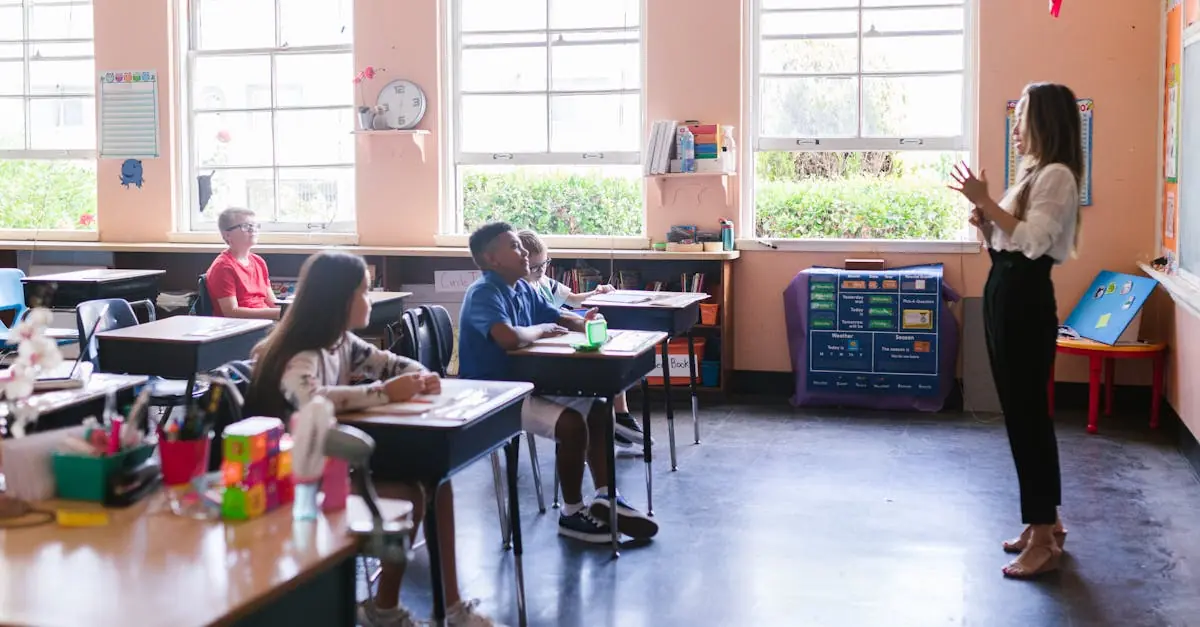Table of Contents
ToggleThe first day of school is like opening a brand new book, filled with blank pages just waiting for adventure. For elementary students, it’s a mix of excitement and nerves, like a roller coaster ride that starts with a thrilling climb. To ease those jitters and kick off the year with a bang, engaging activities can set the perfect tone.
Importance of First Day of School Activities
First day activities play a crucial role in setting the tone for the entire school year. They’re designed to ease students’ transition and boost their confidence. Engaging in these activities helps foster connections among peers, promoting a sense of belonging from the start.
Building community is vital for young learners. Group games and collaborative projects encourage students to interact and form friendships. These connections can significantly enhance the overall classroom environment, making it more welcoming and inclusive.
Creating a safe space is another essential aspect. Activities that focus on sharing feelings and experiences allow students to express themselves. When children understand that their feelings are validated, they feel more secure and open to learning.
Stimulating interest in learning is also a key benefit. Fun and interactive activities can spark curiosity and excitement about the subjects students will explore throughout the year. Engaging them in hands-on tasks makes learning enjoyable and memorable.
Setting expectations and routines effectively is crucial during the first days of school. Activities that highlight classroom rules and procedures help students understand what is expected of them. This clarity leads to a smoother transition into the school year.
These activities can also help teachers gauge students’ interests and strengths. Assessing students through games or creative projects enables educators to tailor instruction to meet individual and group needs. Adapting lessons accordingly improves overall engagement and academic success.
Fun Icebreaker Activities
Engaging icebreaker activities can help create a positive atmosphere on the first day of school. These activities foster connections among students, alleviating nerves and building a sense of community.
Name Games
Name games facilitate introductions among classmates. One popular game involves each student saying their name along with an interesting fact or hobby. This encourages sharing and helps classmates remember each other. Another variation includes the name chain; each student repeats previous names before introducing their own. This game not only breaks the ice but also boosts memory skills. Lastly, a name bingo card can provide a fun challenge, prompting students to find peers who match specific criteria related to their names or interests. Such activities nurture interaction and camaraderie from the start.
Group Challenges
Group challenges promote teamwork and communication. A classic example is the “Tower Building” challenge, where students use materials like blocks or straws to construct the tallest tower in a set time. This encourages collaboration and creativity. Another effective activity is the “Human Knot,” where students stand in a circle, grab hands with others across, and work together to untangle themselves without letting go. This fosters problem-solving and trust. Creating a scavenger hunt tailored to classroom elements also engages students while promoting exploration. These experiences enhance relationships and create a supportive classroom environment.
Classroom Management Strategies
Classroom management plays a critical role in creating a positive learning environment. Proactive strategies help ensure students understand expectations and feel comfortable sharing their thoughts.
Setting Expectations
Clearly communicated expectations foster a productive classroom atmosphere. Initially, detailing classroom rules sets a standard for behavior and engagement. Sharing the rationale behind each rule helps students grasp its importance. Encouraging student input can lead to mutual understanding and respect for these guidelines. Revisiting these expectations throughout the year reinforces their significance and keeps behavior consistent. Additionally, recognizing positive behavior sets a tone of encouragement that motivates students to adhere to expectations.
Establishing Routines
Consistent routines simplify classroom dynamics and enhance student comfort. Starting the day with a predictable morning routine allows students to acclimate quickly. Assigning responsibilities for classroom tasks creates a sense of ownership among students. Using visual schedules provides an easy reference, aiding students in understanding daily expectations. Transitioning between activities smoothly minimizes disruptions, maintaining focus. Emphasizing the importance of routines not only promotes independence but also enables teachers to spend more time on instruction rather than management.
Creative Learning Activities
Creative activities enhance the first day of school experience. Engaging students through fun approaches sets a positive tone for the year.
Interactive Learning Stations
Interactive learning stations engage students with hands-on experiences. Each station can focus on subjects like math, science, or art. For example, a math station could include games that reinforce basic concepts. Such activities keep learners involved and eager to explore new knowledge. A science station might offer experiments or nature observations, allowing for discovery. By moving between stations, students build excitement about learning while improving social skills. Teachers can also tailor station activities to include students’ interests, making learning personal and relevant.
Team-Building Exercises
Team-building exercises foster cooperation among students. Group challenges, such as a scavenger hunt, encourage problem-solving. Participants work together to find specific items or complete tasks, enhancing teamwork. Such activities help them develop trust and communication skills. Another effective exercise is an obstacle course, where students navigate challenges as a group. These creative experiences create bonds and a sense of community from the very start. Building an environment centered around teamwork motivates students to support one another throughout the school year.
Engaging Parents on the First Day
Engaging parents on the first day of school strengthens the connection between home and the classroom. Parents can participate in welcome activities, helping them feel involved in their child’s education. Organizing a brief orientation for caregivers provides an opportunity to share classroom expectations and routines. Teachers can present a concise overview of the curriculum, highlighting key subjects and goals for the year.
At this event, establishing communication methods is vital. Providing parents with information about newsletters, emails, and platforms for updates fosters ongoing dialogue. Encouraging them to ask questions creates a welcoming atmosphere where collaboration thrives.
Creating a designated area for parents to mingle enhances the experience. Offering light refreshments while children participate in activities allows families to connect with each other. This fosters a sense of community right from the start. Sharing resources, such as a list of volunteer opportunities, invites parents to get involved and contribute to their child’s school experience.
Another effective method involves sending home an introductory letter. This letter can outline classroom norms, schedule, and details about upcoming events. It reassures parents about their child’s learning environment while inviting feedback about their preferences and concerns.
Crafting interactive experiences also engages parents. Activities that invite parent participation, like a collaborative art project, create shared memories and conversations about school. Such involvement bolsters student confidence knowing their families are actively participating in their educational journey.
By focusing on these engagement strategies, schools can cultivate a supportive network that benefits students, parents, and teachers alike.
The first day of school is a pivotal moment for elementary students. Engaging activities not only ease anxiety but also lay the groundwork for a successful year. By fostering connections and building community, teachers can create a supportive environment that encourages interaction and friendship.
Clear expectations and routines help students feel secure and ready to learn. Incorporating fun and creative experiences keeps students motivated and excited about their education.
When parents are involved from the start, it strengthens the bond between home and school. Overall, these strategies contribute to a positive classroom atmosphere that enhances both academic success and social development.





